I've posted over the last few months about my trials and tribulations on procuring side window glass for my second gen and I'm happy to report that
I now have two new, perfect fitting windows! Along the way I've learned more about auto glass then I ever thought I would need to know. I'm going to explain the path I took and what I learned so it will hopefully benefit others. I can't guarantee that any particular vendor/supplier is the best place to purchase as I suspect it may still be hit or miss, but this info should at least increase your chances of getting good fitting windows.
Installing my new windows also gave me an opportunity to use the 3D printed window gauge blocks for alignment. I can tell you up front that they work great...but only if you have good glass to work with. If you're trying to align glass with incorrect dimensions then you will struggle. With glass that has accurate dimensions, the alignment process should be at max a 5-10 minute process. This is assuming that you've gotten familiar with the adjustment points and the proper sequence of steps as outlined in the GM repair manual. If the sticky post on these gauge blocks gets re-posted, I'll update that thread on the process.
Because my previous glass posts are lost in the site crash, I'll start at the beginning. I originally purchased OER brand replacement windows from Summit Racing, but after installing the passenger side it had clearance issues at both edges. The issue turned out the be too much curvature as shown in the photo below.
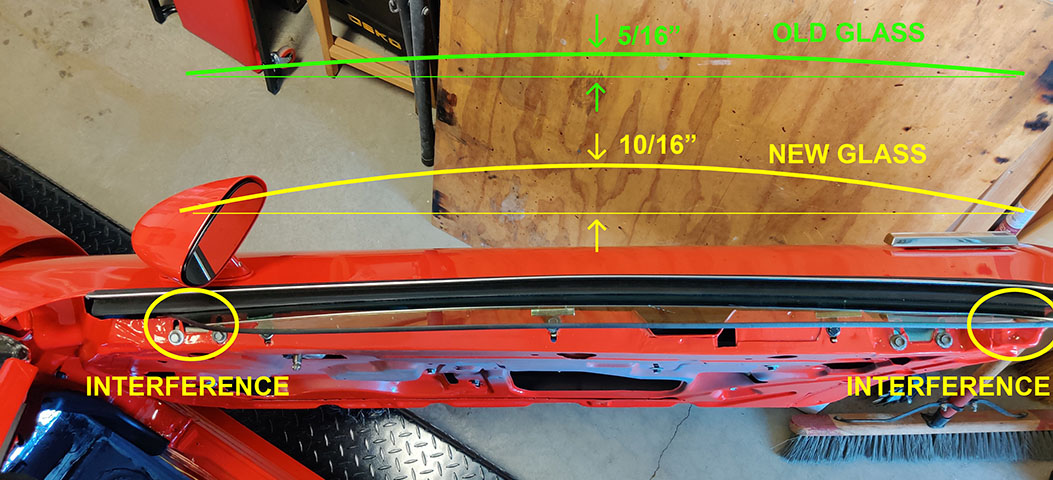
Too much curvature creates problems once the outer weatherstripping is installed as it pushes the window inboard too much. Trying to push it back outboard to clear the edges actually started to distort the door skin. The way I measured the curvature was to pick a point in the center of the window 10 inches from the top, lay a straight edge across the windows horizontally and measure the distance from the straight edge to the inside surface of the glass.
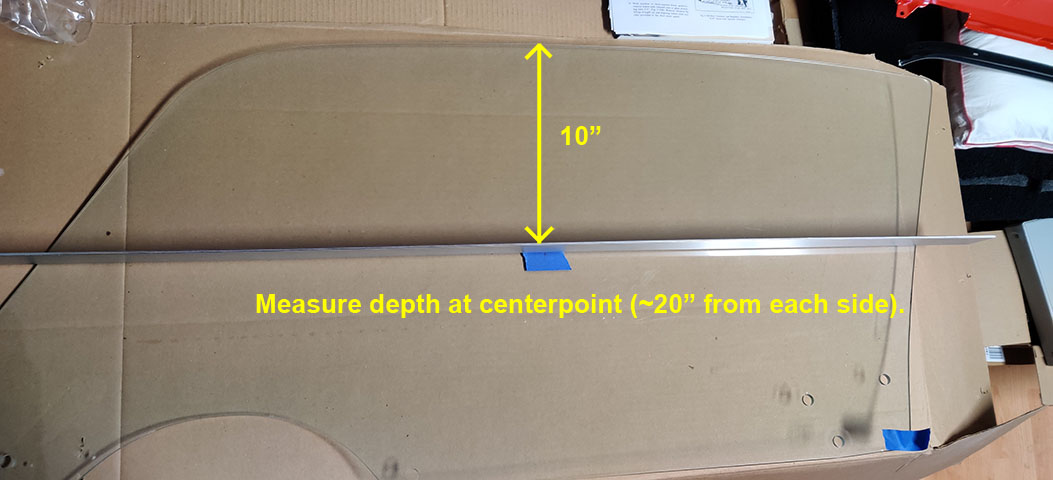
My original OEM windows measured 5/16" and the OER brand passenger window was 5/8", double the OEM dimension.
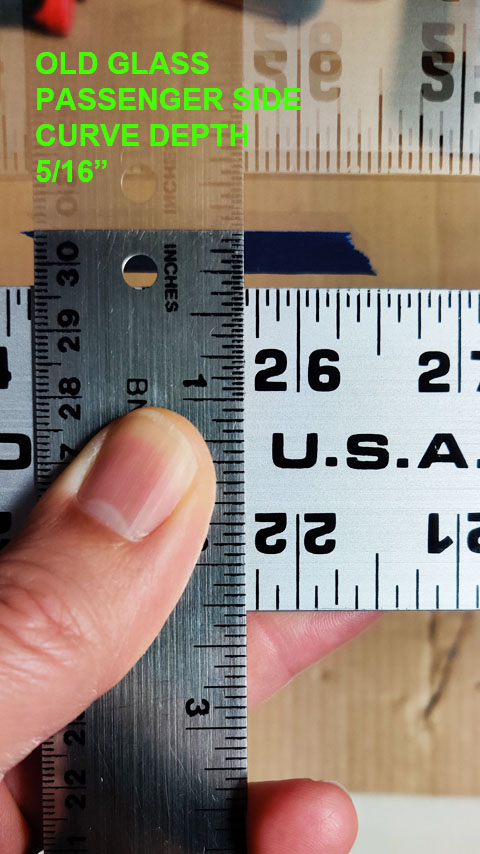
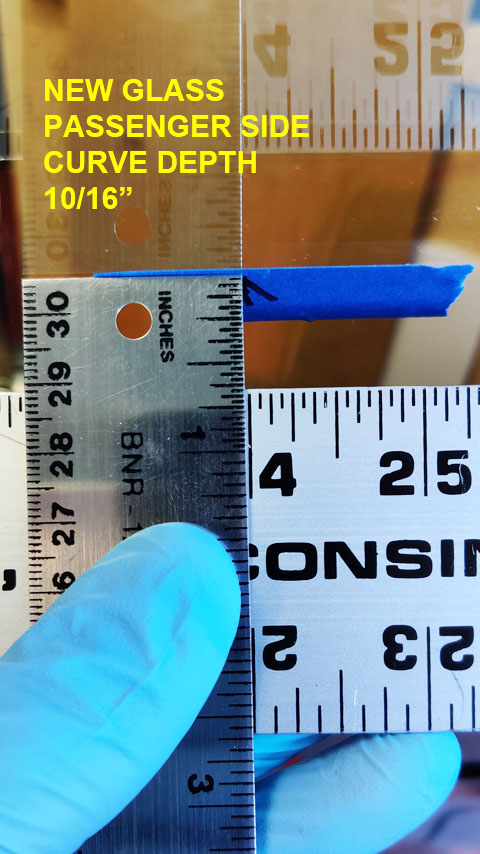
The OER driver window measured at 1/2", not as bad but still considerably more curved than OEM. At this point I decided to return the OER glass in exchange for Pilkington brand at double the price. Pilkington had a reputation for good quality and I assumed you get what you pay for. Unfortunately both windows were backordered for two months out so in the meantime I installed my old original OEM driver side glass to get a feel for what correct fitting glass was like. It was night and day different. The whole alignment process was quick and simple, and it made me realize that bad reproduction glass is most likely the reason people complain about aligning their windows.
Two months later the Pilkington passenger window arrived and I went to Summit Racing to pick it up and return the OER glass. The curvature of the Pilkington measured out perfectly but I also found out that Pilkington had closed down their classic auto glass division and I wouldn't be able to get the driver side through them. While at the store we measured 3 other OER driver side pieces and they were all bad.
Still in need of a driver side window, I started searching numerous vendors and tried to find out as much info as possible on glass quality. I even talked to an auto glass locating service (didn't know there was such a thing before this). Throughout all of my searching it was always unclear where the sellers were getting their glass from and if they were all getting from the same supplier. Eventually I ran across a craigslist ad in Southern California for reproduction classic auto glass from an obscure seller. Gave him a call and his name was Brian and his business is called SoCal Classic Autoglass Connection. Brian was immensely helpful, his pricing was reasonable, he was confident that his product was good and offered to pay for return shipping if the glass didn't work out. After a lengthy discussion I decided to place an order through him via PayPal.
In the discussion with Brian I learned that each glass supplier has their own unique DOT (Department of Transportation) number which will be etched or printed on the glass. Even if there are no other markings there should always be a DOT number. So you can check any vender's product for the DOT number and know where they get their glass from. Ultimately the quality of the glass rests on the supplier (with their unique DOT number), not who the seller is. There are several public databases of DOT suppliers on the web although not all of them are completely up to date. Here are a couple.
https://www.carwindshields.info/dot_db (this one goes up to DOT904)
https://www.glassbytes.com/dot/index.php (this one goes up to DOT1161)
Brian told me he sells glass labeled DOT686 which is a Taiwan supplier. My Pilkington passenger window is DOT509, my PGW windshield is DOT563, original LOF (Libby Owens Ford) is DOT15, etc.
Side note, if you want to learn more about OEM glass check out this page -
http://www.camaros.org/glass.shtml. It's for first gen Camaros but still pertinent.
A couple days later I got a call from Brian and he informed me that National Parts Depot bought up all the driver side windows from his supplier and it would be a couple months before he could get one for me. He knew I was anxious to get the window so he offered to refund my money so I could order through NPD. He followed through on the refund and I placed a new order through NPD. When the window arrived it measured out perfectly on the curvature, and it turned out to be labeled DOT686 which is the same supplier that Brian described that he uses.
So I had both windows now with the right curvature but the story doesn't end there. I started installing the Pilkington passenger window using the gauge blocks and everything went smooth, although I noticed one problem - that the rear edge was very close to the C-pillar molding. It was so close that it just barely cleared the molding when opening/closing.
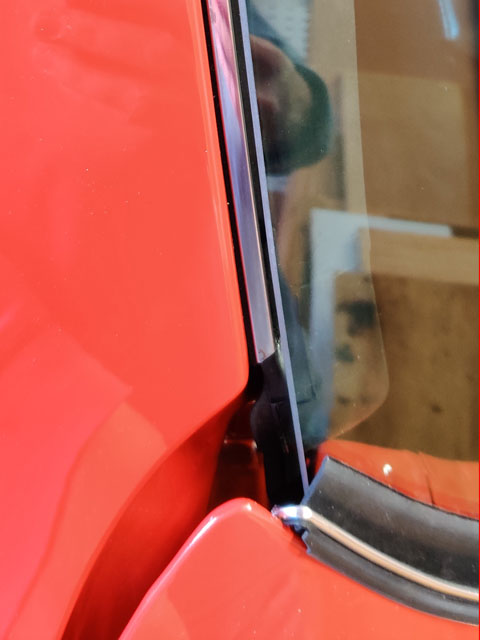
The alignment gauge blocks provide three reference points for alignment, two on the top edge and one on the front edge. The rear edge will fall where it does based on the front being in the correct position. Since the front was aligned correctly I checked the overall length front to back and found it to be 5/16" longer compared to the OEM window that I had semi-installed on the driver side. The problem this creates is that the window weatherstripping is very thick and dense at it's base, particularly at the top and bottom of the C-pillar. With the extra length of the Pilkington window it ends up lying on the thick non-compressible portion of the weatherstrip seal and would make the door very difficult to close. The driver side OEM window had a much more reasonal gap between the C-pillar and the edge to where it fell on a thinner/softer portion of the seal. So I started comparing window length to the different pieces of glass I had on hand. I actually have four OEM windows, two that came with the car and two I picked up on craigslist along the way. This gave me a decent sample size of OEM glass for comparison.
Since the window edges aren't straight it's difficult to find a good reference point for measuring length. What I did was create a template of the overall window shape out of cardboard using one of the OEM windows as a reference. I then compared the shape of the cardboard to all the other window shapes by lining up the front and top edges and documented the variance of the length dimension at the rear edge. Here's a photo of the reference cardboard after lining up the front edge demonstrating the difference in length.
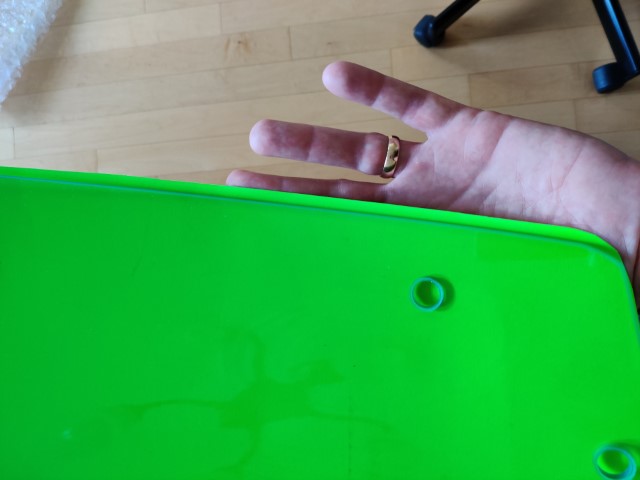
The OEM window I chose for reference happened to be one of the larger ones so all of the others measured smaller, EXCEPT for the Pilkington glass which turned out the be the largest of all the windows I had.

You can see from the table that there was variance across all the glass, even the OEM ones. My guess is that the edge finishing was/is a manual process and naturally prone to variances. Given the variances it's hard to determine which one is the "correct" dimension, but I would prefer to use the "shorter" length due to how I described it sitting on the weatherstrip seal. So I'm estimating that 1/4" smaller to my reference is the target dimension. Interestingly the NPD (DOT686) glass measured closer to the OEM glass than the Pilkington. So the Pilkington supplier got the hard part right (the curvature) but got the easy part wrong (length). I contemplated taking the glass to a local glass shop to see if they could shorten the length, but decided instead to order another passenger window from NPD to see if it fit as well as the driver side one. That one turned out to measure perfectly on curvature AND on length, matching the driver side NPD glass exactly. Because of this I couldn't see paying a premium for the Pilkington since it wasn't going to fit as well as the less expensive glass and returned the Pilkington to Summit.
So the bottom line is that there are two critical dimensions to look for on window glass, the curvature and overall length. As I mentioned earlier, it may still be hit or miss but paying attention to these two dimensions you will know how close to OEM it is. If the window is aligned using the gauge blocks you should target about 1/2" clearance between the rear edge of the window and the weatherstripping channel (or 3/4" clearance to the base of the channel). BTW, I'm not using the extra layer of chrome molding on the C-pillar, using that would decrease the clearance.
I can recommend DOT686 door glass available from NPD and SoCal Classic Autoglass Connection. Brian's price was reasonable but his shipping was higher, so if you are in Southern California I wouldn't hesitate to buy from him and pick up locally. His number is (760) 807-8968.
I started the table below of suppliers and distributors, and identifying if the supplier's glass was good or not (green is good, red is bad). I also added front and rear windows to the list as well, but not sure if each supplier produces all four pieces. I know PGW doesn't make anything besides windshields for second gen F-body. Unfortunately I returned the OER side windows before noting the DOT number but I did list their crappy rear window I got from them, it may or may not be the same number. The NPD rep told me over the phone that they use a supplier called JR Distributor International but that doesn't jive with the DOT 686 number, so maybe they switched suppliers??
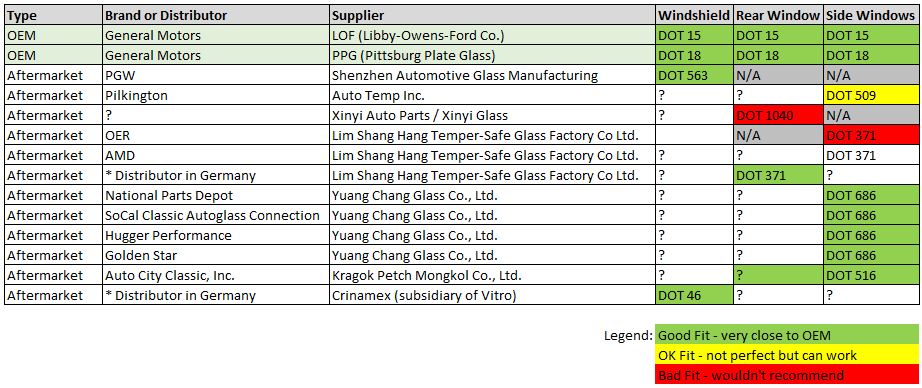
If anyone wants to share their experience with their glass and the DOT number in order to build out this table further, that would be helpful. It would be interesting to know who the suppliers are for AMD and Auto City Classics. Also with more data it will help determine if a supplier is consistent on their quality.